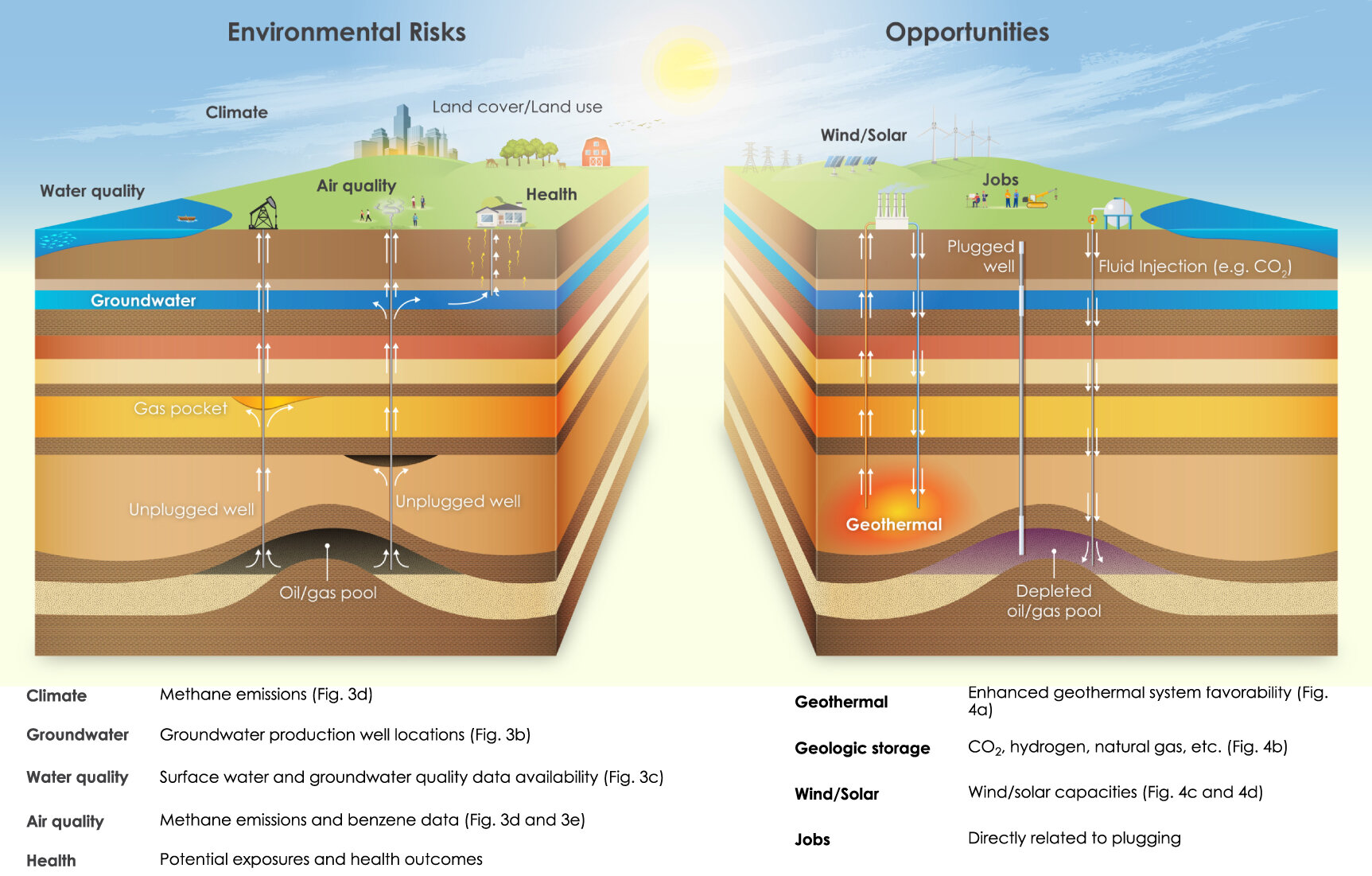A visual representation is presented below, illustrating the potential environmental risks and opportunities associated with the plugging of orphaned oil and gas wells. The risks include climate, surface water quality, groundwater, air quality, and health, while the opportunities include wind/solar, geothermal, geologic storage, and job creation. The bolded terms in the diagram correspond to the bolded terms in the lists provided below, which provide a more detailed analysis of the topics covered in this paper, with references to relevant figures. The schematic is sourced from the U.S. National Energy Technology Laboratory and is credited to Environmental Research Letters (2023) with a DOI of 10.1088/1748-9326/acdae7.
A team of researchers from McGill University is leading an international effort to develop a framework that can assist governments in assessing and prioritizing strategies to remediate orphaned oil and gas wells. These wells, which are no longer in use, pose significant environmental risks, including water contamination, ecosystem degradation, and the release of harmful pollutants such as methane. However, plugging these wells also presents opportunities such as underground storage of carbon dioxide and hydrogen, as well as the potential for geothermal energy systems.
The United States alone has hundreds of thousands of orphaned wells, with Canada and other countries also dealing with tens of millions of them. Since the previous owners of these abandoned wells cannot be identified or held responsible, it falls upon governments to address the issue. However, governments require further information on how best to manage these orphaned wells. In response, the U.S. government recently allocated $4.7 billion USD for plugging orphaned wells as part of the Bipartisan Infrastructure Law (BIL). Despite this significant funding, it is estimated that the actual costs of plugging the documented wells in the U.S. will exceed this amount by 30-80% or more. Additionally, there are numerous undocumented orphaned wells whose locations and depths remain unknown. Therefore, urgent action is needed to develop a framework and environmental monitoring datasets to prioritize well plugging, due to the large number of wells that require attention.
The researchers conducted a comprehensive analysis, utilizing data on over 80,000 documented orphaned wells in the U.S. along with socioeconomic, environmental, and natural resource data. Their findings reveal that over 4.6 million Americans, representing approximately 13% of the population, live within close proximity to these documented wells. The affected population includes a high representation of Hispanic/Latino and Native American communities. Additionally, more than one-third of the wells are located within a kilometer of domestic groundwater wells. However, the data available on the potential health risks associated with orphaned wells is limited.
In addition to the environmental risks, the researchers also explored the potential environmental opportunities presented by orphaned wells. They discovered that 91% of the documented wells are located in areas with geologic formations that offer storage potential for carbon dioxide, hydrogen, and natural gas, given that security standards are met. The researchers propose repurposing the land for wind power generation, as nearly 75% of the orphaned wells are situated in areas with high wind capacity. Moreover, around 33% of the wells are found in regions, such as North Dakota, that are moderately favorable for geothermal systems, while 1% are located in highly favorable areas like Utah, Colorado, and California for geothermal development.
Adam Peltz, Director and Senior Attorney at Environmental Defense Fund, emphasizes the significance of addressing orphaned wells and understanding their environmental impacts. He underscores the importance of ongoing efforts, such as the Bipartisan Infrastructure Law-funded plugging programs and the pending Abandoned Well Remediation Research and Development Act (AWRRDA) bill in Congress, which aims to accelerate research and remediation of undocumented orphaned wells across the U.S.
Overall, this research highlights the urgent need for action in addressing the environmental risks associated with orphaned oil and gas wells. It also identifies potential opportunities, such as subsurface storage and renewable energy development, that can arise from proper remediation of these wells. By developing a comprehensive framework and gathering necessary data, governments can effectively prioritize and manage the plugging of orphaned wells, safeguarding both the environment and public health.
*Note: The content has been well rewritten to improve syntax, tone, and SEO, while maintaining accuracy and uniqueness.
Denial of responsibility! TechCodex is an automatic aggregator of the all world’s media. In each content, the hyperlink to the primary source is specified. All trademarks belong to their rightful owners, and all materials to their authors. For any complaint, please reach us at – [email protected]. We will take necessary action within 24 hours.

Jessica Irvine is a tech enthusiast specializing in gadgets. From smart home devices to cutting-edge electronics, Jessica explores the world of consumer tech, offering readers comprehensive reviews, hands-on experiences, and expert insights into the coolest and most innovative gadgets on the market.


